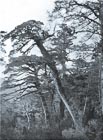Conservation Status

Tsuga sieboldii
Carrière (1855)
Common names
Southern Japanese hemlock; ツガ tsuga, Toga matsu [Japanese].
Taxonomic notes
Type: Japan, P. F. von Siebold s.n. (lectotype M). There are 8 synonyms (see POWO), none in common use. T. sieboldii belongs to the Asian clade of Tsuga. Molecular analysis using nuclear, chloroplast and mitochondrial markers has elucidated its origins. The chloroplast and mitochondrial evidence indicate T. sieboldii arose from hybridization between the common ancestor of T. chinensis and T. forrestii as the paternal donor, and the common ancestor of T. diversifolia and T. ulleungensis as the maternal donor. The common ancestor of T. sieboldii and T. formosana then dispersed to Taiwan, and although there was significant divergence between the two after that speciation event, they remain sisters (Feng et al. 2021).
Description
Evergreen monoecious trees to 30 m tall and 250 cm dbh, with a usually single, straight or curved trunk and a broadly conical crown becoming irregular and often flat-topped with age. Bark dark gray, rough, scaly, forming quadrangular plates. Twigs light brown, graying with age, barely grooved between decurrent pulvini, glabrous. Leaves of unequal length: above shoot parted, assurgent; otherwise pectinate, 10-15 × 2-2.5 mm, widest near blunt or emarginate apex, flattened, grooved above, stomata in two bands below, light green. Pollen cones 3-5 mm, crowded together, yellow. Seed cones borne on outer branches throughout crown, sessile, globose when open, (16-)20-25(-30) mm long, 14-20 mm wide, green ripening to pale brown, scales nearly round, 8-12 mm diameter; seeds 2-3 × 1.5 mm with on oblong wing 5-6 × 3 mm, light brown, tranparent (Farjon (2010).
Distribution and Ecology
Japan: S Honshu, Shikoku, Kyushu and Yakushima (Farjon 1990), at 500-1500 m elevation. Soils various, silicic; climate moist temperate, maritime, 1000-2000 mm annual precipitation. Commonly grows in mixed conifer forest; typical associates include Abies firma, Pseudotsuga japonica, Chamaecyparis obtusa, Cryptomeria japonica, Pinus densiflora, Pinus parviflora, and Sciadopitys verticillata; rarely in pure stands (Farjon (2010). Hardy to Zone 6 (cold hardiness limit between -23.2°C and -17.8°C) (Bannister and Neuner 2001).
Remarkable Specimens
Wilson (1916, p. 50) reports "On Yaku-shima, where the finest development of Tsuga Sieboldii is found, the trees rarely exceed 26 m. in height, but many are fully 6 m. in girth of trunk, and are picturesque in appearance."
Suzuki (1997) studied this species on Yakushima Island (屋久島). He cites his own previous work (Suzuki and Tsukahara 1987) in having found a tree stump with 794 rings on Yakushima. He also cites other previous workers as having derived ring-counted ages of 685 years on Ulleungdo (37.500°N, 130.833°E), and 639 years on Mt. Oninome, Miyazaki, Japan (32.700°N, 131.533°E).
Ethnobotany
Less common and less widely used than Tsuga diversifolia, but still used for construction, carpentry, and furniture making. A popular ornamental in Japan, it is much less common in Europe and North America (Farjon (2010). The species has also been explored for use in dendrochronology, in two studies dealing with tree demography (Suzuki 1980, Suzuki and Susukida 1989).
Observations
Wilson (1916) says it is a popular ornamental in Tokyo, near its northern range limit, but is best seen on Yakushima, where it grows at 600-1500 m elevation in forests with Cryptomeria japonica and Abies firma. Most of the island is protected in Yakushima National Park, and most of the forests seen by Wilson remain intact.
Remarks
Citations
Farjon, Aljos. 1990. Pinaceae: drawings and descriptions of the genera Abies, Cedrus, Pseudolarix, Keteleeria, Nothotsuga, Tsuga, Cathaya, Pseudotsuga, Larix and Picea. Königstein: Koeltz Scientific Books.
Feng, Yuan-Yuan, Ting-Ting Shen, Cheng-Cheng Shao, Hong Du, Jin-Hua Ran, and Xiao-Quan Wang. 2021. Phylotranscriptomics reveals the complex evolutionary and biogeographic history of the genus Tsuga with an east Asian-North American disjunct distribution. Molecular Phylogenetics and Evolution 157:107066. https://doi.org/10.1016/j.ympev.2020.107066.
Suzuki E. 1980. Regeneration of Tsuga sieboldii forest II. Two cases of regeneration occurred about 260 and 50 years ago. Japanese Journal of Ecology 30: 333-346 [in Japanese with English summary].
Suzuki E. and Tsukahara J. 1987. Age structure and regeneration of old growth Cryptomeria japonica forests on Yakushima Island. Bot. Mag. Tokyo 100:223-241.
Suzuki E. and Susukida J. 1989. Age structure and regeneration process of temperate coniferous stands in the Segire River basin, Yakushima Island. Japanese Journal of Ecology 39: 45-51 [in Japanese with English summary].
Suzuki Eizi. 1997. The dynamics of old Cryptomeria japonica forest on Yakushima Island. Tropics 6(4):421-428.
Wilson, E.H. 1916. The conifers and taxads of Japan. Publ. Arnold Arbor. 8, Univ. Press, Cambridge, Mass. Available: Biodiversity Heritage Library, accessed 2021.12.19.
See also
Elwes and Henry 1906-1913 at the Biodiversity Heritage Library. This series of volumes, privately printed, provides some of the most engaging descriptions of conifers ever published. Although they only treat species cultivated in the U.K. and Ireland, and the taxonomy is a bit dated, still these accounts are thorough, treating such topics as species description, range, varieties, exceptionally old or tall specimens, remarkable trees, and cultivation. Despite being over a century old, they are generally accurate, and are illustrated with some remarkable photographs and lithographs.
Holman, G., P. Del Tredici, N. Havill, N. S. Lee, R. Cronn, K. Cushman, S. Mathews, L. Raubeson, and C. S. Campbell. 2017. A new species and introgression in eastern Asian hemlocks (Pinaceae: Tsuga). Systematic Botany. 42(4):733–746.
Yamanaka, T. 1975. Ecology of Pseudotsuga japonica and other coniferous forests in eastern Shikoku. Mem. Nat. Sci. Mus. 8. Tokyo.



